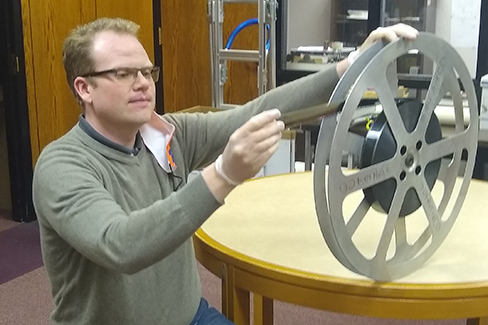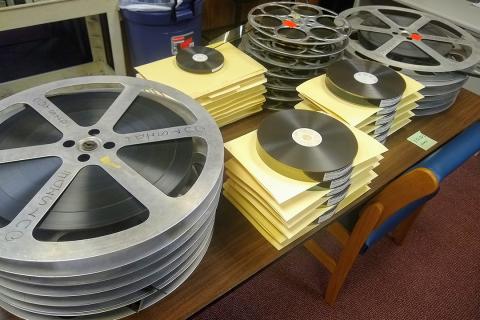(August 31, 2022)
UTSA has been awarded a two-year, $240,442 grant from the Institute of Museum and Library Services (IMLS) for UTSA Libraries to digitize and catalog audiovisual items that were produced by the Institute of Texan Cultures for classroom and museum instruction, entertainment, and more, over a nearly 50-year span.
Known as Faces and Places of Texas: Preserving and Digitizing the Institute of Texan Cultures’ Audiovisual Collections, the project will kick off in September 2022. Informed by a previous assessment of the collection that identified conservation priorities, the project will entail cataloging and rehousing more than 3,000 multimedia items and digitizing 200 of the most at-risk formats within the collection.

“The IMLS grant provides an exciting opportunity to provide our students with valuable training preparing them for future careers while leveraging the unique expertise of UTSA as an R1 university through this collaboration among UTSA Libraries Special Collections, the Institute of Texan Cultures, and the College of Liberal and Fine Arts,” said Kimberly Andrews Espy, provost and senior vice president for academic affairs. “The project will further the university’s commitment to ensure the ITC resources are preserved, maintained and available to all those interested in the rich cultures of Texas, aligned with the results of the ITC 2068 Community Stakeholder Visioning process.”
ITC’s first audiovisual presentation, “Faces and Places of Texas,” debuted at the opening of the ITC in 1968.
“The production of audiovisual media was a key element of the ITC’s mission from its founding,” said Dean Hendrix, UTSA vice provost and university librarian. “The digital components created during the project will provide a solid foundation for a future phase to provide open online access to the digitized files. Providing online access will allow students, researchers, UTSA faculty, museum staff, and citizens across Texas and the world to understand and appreciate the history and culture of the diverse communities living and thriving throughout Texas as documented by the ITC.”
The project will be led by Special Collections, a division of UTSA Libraries that preserves and provides access to UTSA’s archives, manuscript collections, rare books, and photo archives. The collection of treasured multimedia items has been carefully compiled by the ITC staff over five decades for the education, enlightenment and enjoyment of future generations of Texans.
“It has long been a goal of Special Collections to locate all of these films and tapes, catalog them, and digitize the ones that are most at risk of being lost forever due to format obsolescence and degradation,” said Amy Rushing, assistant vice provost for UTSA Special Collections and project director.

The ITC audiovisual collection includes audio tapes, U-Matic and Betacam videocassettes, video reels, and 16mm and 35 mm motion picture films produced by the ITC from 1968 to the 2000s. Due to the collection’s size, significant resources will be needed to process, describe, and preserve it. The grant will allow the hiring of an audiovisual archivist to survey the collection and standardize project metadata as well as an external vendor who will be contracted to digitize prioritized at-risk items from the collection.
The project will also provide practical Classroom to Career experience and training for students. Graduate and undergraduate student assistants from the College of Liberal and Fine Arts digital initiatives program headed by Seok Kang, professor of communication, will aid staff in the cataloging and rehousing of the collection.
Content on the multimedia items slated for preservation includes a number of culturally significant projects:
- The original 1968 dome show, which comprises motion picture films, open reel audio tape, and slide transparencies
- Videos created for classroom use with accompanying teacher guides and traveling trunks. Topics included African American cowboys, contemporary Native American communities, the Polish settlement of Panna Maria, the social history of World War II in Texas, historical architecture, and various aspects of Tejano history and culture.
- Videos that were created to be shown on the exhibit floor for museum visitors. These include a series of interviews with former internees of the Crystal City Internment Camp and a series of documentary videos capturing Tejano cultural life in Texas border communities
- Film and video that documents the Texas Folklife Festival
- “Lifetimes: The Texas Experience,” a series of historical vignettes which aired on several Texas radio stations from 1994 to 2000.
“The project is the perfect example of what can be done through collaboration. Dr. Kang’s digital initiative students will gain valuable hands-on skills and experience, and the ITC curators and student interns will be able to utilize the content in new ways of storytelling and exploring cultural intersections,” said Rushing.
“Most important, we will preserve and make discoverable for the benefit of future generations of Texans a unique and invaluable audiovisual collection. There is so much potential for what can be done with the content.”
IMLS is an independent federal agency that provides library grants, museum grants, policy development, and research in support of its goals to promote lifelong learning, build capacity and increase public access. IMLS awarded $23.3 million in funding to Texas agencies in FY 2021.
The UTSA grant was provided through the IMLS Museums of America program, which supports strategic, project-based efforts to serve the public through exhibitions, educational/interpretive programs, digital learning resources, professional development, community debate and dialogue, audience-focused studies, and/or collections management, curation, care, and conservation.